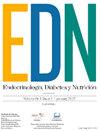Exploring plantar pressure distribution in patients with newly diagnosed diabetes: Implications for foot ulcer prevention in an overweight Mexican population
IF 1.8
4区 医学
Q4 ENDOCRINOLOGY & METABOLISM
引用次数: 0
Abstract
Introduction
Elevated plantar pressure (PP) constitutes a risk factor for developing foot ulcers. Once present, elevated PP increases morbidity and mortality in patients with diabetes. Given the high prevalence of overweight and obesity in the Mexican population, this study aimed to describe the magnitudes and the distribution of the PP observed in a sample of newly diagnosed patients with diabetes, adjusting for body mass index (BMI) groups (normal weight, overweight, grade I obesity, and grade II and III obesity).
Materials and methods
A total of 250 volunteers attending a comprehensive care program for the management of type 2 diabetes received foot assessments that included vascular and neurological evaluation, the identification of musculoskeletal changes, and measurements of PP.
Results
Diabetic neuropathy and peripheral arterial disease were present in 21.6% and 11.2% of all participants. Musculoskeletal alterations were present in 70.8% of participants. A positive and significant correlation (p < 0.001) was observed between BMI and the peak PP of all anatomical regions assessed. After adjusting for BMI, significant differences (p < 0.001) were seen between groups. The metatarsal region, particularly under the third metatarsal head, denoted the highest magnitudes across all BMI.
Conclusions
Periodic PP assessment is recommended to identify the distribution of high-pressure points along the plantar surface. However, as a preventive measure, it is suggested to encourage patients with diabetes and overweight or obesity to wear appropriate footwear and pressure-relief insoles to relieve high-pressure areas – often seen in these populations – to help prevent foot complications.
探索新诊断糖尿病患者的足底压力分布:对墨西哥超重人群足部溃疡预防的启示
导言:足底压力(PP)升高是导致足部溃疡的一个危险因素。足底压力一旦升高,就会增加糖尿病患者的发病率和死亡率。鉴于墨西哥人口中超重和肥胖的发病率很高,本研究旨在描述在新诊断的糖尿病患者样本中观察到的足底压力的大小和分布情况,并根据体重指数(BMI)分组(正常体重、超重、I 级肥胖、II 级和 III 级肥胖)进行调整:共有 250 名志愿者参加了 2 型糖尿病综合治疗项目,他们接受了足部评估,包括血管和神经评估、肌肉骨骼变化鉴定以及 PP 测量:在所有参与者中,分别有 21.6% 和 11.2% 的人患有糖尿病神经病变和外周动脉疾病。70.8%的参与者存在肌肉骨骼变化。两者之间存在明显的正相关(p结论:建议定期进行 PP 评估,以确定足底高压点的分布情况。不过,作为一项预防措施,建议鼓励糖尿病、超重或肥胖症患者穿着合适的鞋袜和减压鞋垫,以缓解这些人群中经常出现的高压区,从而帮助预防足部并发症。
本文章由计算机程序翻译,如有差异,请以英文原文为准。
求助全文
约1分钟内获得全文
求助全文
来源期刊

Endocrinologia Diabetes Y Nutricion
Multiple-
CiteScore
2.10
自引率
10.50%
发文量
99
期刊介绍:
Endocrinología, Diabetes y Nutrición is the official journal of the Spanish Society of Endocrinology and Nutrition (Sociedad Española de Endocrinología y Nutrición, SEEN) and the Spanish Society of Diabetes (Sociedad Española de Diabetes, SED), and was founded in 1954.
The aim of the journal is to improve knowledge and be a useful tool in practice for clinical and laboratory specialists, trainee physicians, researchers, and nurses interested in endocrinology, diabetes, nutrition and related disciplines.
It is an international journal published in Spanish (print and online) and English (online), covering different fields of endocrinology and metabolism, including diabetes, obesity, and nutrition disorders, as well as the most relevant research produced mainly in Spanish language territories.
The quality of the contents is ensured by a prestigious national and international board, and by a selected panel of specialists involved in a rigorous peer review. The result is that only manuscripts containing high quality research and with utmost interest for clinicians and professionals related in the field are published.
The Journal publishes Original clinical and research articles, Reviews, Special articles, Clinical Guidelines, Position Statements from both societies and Letters to the editor.
Endocrinología, Diabetes y Nutrición can be found at Science Citation Index Expanded, Medline/PubMed and SCOPUS.
 求助内容:
求助内容: 应助结果提醒方式:
应助结果提醒方式:


